Saturday, March 28, 2020
Weekly Indicators for March 23 - 27 at Seeking Alpha
- by New Deal democrat
My Weekly Indicators post is up at Seeking Alpha.
As you might expect, almost all of the “hard” indicators have crashed. What sticks out is that consumer spending, as measured by chain store sales, has not - even though one week ago the coronavirus restrictions were very much in place in many regions.
As usual, clicking over and reading will bring you thoroughly up to date. It also helps reward me for my efforts, especially now that I have cut back on posting there in order to spend a lot of time documenting what is happening and what is likely to happen going forward with the coronavirus pandemic.
Coronavirus dashboard for March 28: testing falls further behind
- by New Deal democrat
Here is the update through yesterday (March 27)
In order to succeed in containing the pandemic, I believe that the US needs 2 weeks of China (nearly complete lockdown) followed by at least a month of South Korea (very aggressive and widespread testing).
At minimum, that means at least 50% of the US population under lockdown and a ratio of 15:1 in tests to results showing infection. The recent exponential growth of about 35% per day must be stopped. Those three most important metrics are starred (***) below.
As of now, just over 50% of the population is under total or business lockdown, and the rate of increase in new infections decelerated significantly - but is still growing at near 25%/day. The amount of testing continues to increase, but still is falling far short of what is necessary for a successful regimen.
Number and rate of increase of Reported Infections (from Johns Hopkins via arcgis.com)
- Number: up +18,825 to 104,837 (vs. +16,815 on March 27)
- ***Rate of increase: day/day: 22% (vs. 34.6% baseline and vs. 24% on March 27)
I am using Jim Bianco’s excellent exponential projection of 34.5% growth from March 10 as my baseline. It appears that “social distancing” strategies as well as State-mandated partial and total lockdowns may have begun to put a dent in the exponential rate of increase, as the average rate of increase for the past 4 days has been 22.5%.
Note: Ben Engebreth, whose Department of Numbers used to track house prices back in the housing bubble days, has started tracking coronvirus infection and testing numbers, with graphs. You can find it here.
Number and rate of increase of testing (from COVID Tracking Project)
- Number: 107,329, up +9,523 vs. 97,816 on March 26 day/day
- Rate: increase of 10% vs. number of tests previous day
Comparison of rates of increase in documented infections vs. testing
- Infections +22% vs. Tests +10% day/day
Result: The rate of testing is failing to improve and is far, far below what is needed, which is probably now at least 200,000/day. Note this number is also increasing exponentially as we try to chase the number of exponentially increasing infections.
Ratio of tests to positives for infection (from COVID Tracking Project)
- Number: 107,329 new tests vs. 18,712 new diagnosed infections
- ***Ratio: 5.7:1
In South Korea, where aggressive testing has led to a near-total disappearance of new cases, the inflection point where the number of new daily cases plateaued was reached when the ratio of tests to new cases found reached 15:1. Any ratio less than that suggests that not enough testing is being done. Yesterday’s ratio of 5.7:1 is poor - and has been worsening for the past week, I.e., we are falling further and further behind in testing.
Number of States (+DC and Puerto Rico) in total lockdown, business lockdown, and partial restrictions
- Total lockdown (personal + business): 25 (AK, CA, CO, CT, DE, HI, ID, IL, IN, LA, MN, NC, NH, NM, MI, MT, NJ, NY, OH, OR, PR, VT, WA, WI, WV)
- Business lockdown: 7 (DC, KY, MA, MD, ME*, NV, PA*)
- Partial restrictions on business (restaurants and bars): 14 (AL, FL*, GA*, IA, MO*, MS, ND, RI, SC*, TN*, TX*, UT*, VA, WY)
- School closure only: 5 (AZ**, AR, KS, OK**, SD)
- No mandatory restrictions: 1 (NE*)
*some local areas are under lockdowns
**some local areas with partial restrictions
With the exception of Arizona, all of the remaining States with no restrictions or only school closures are rural. The only news today is that North Carolina (a big State) and Alaska both went to Statewide lockdowns.
Number and percent of US population in total lockdown, business lockdown, and partial restrictions
- ***Total lockdown: 153.2 million, 46.2%
- ***Business lockdown: 39.2 million, 11.8%
- Partial restrictions on business (bars, restaurants): 104.4 million, 31.5%
- School closure only: 15.7 million, 4.7%
- No mandatory restrictions: 1.9 million, 0.6%
Earlier this week, there was a decisive move towards more restrictive measures across the board. This has all but ground to a halt across the southern “red” States. Continued exponential growth in those cases will teach a brutal lesson.
Over half of the total US population, including metro areas in some non-lockdown States, is under total lockdown. That is the percentage, AT MINIMUM, I think we need to have a chance of following China’s successful strategy for beating back the pandemic.
The deceleration of the rate of increase in new cases may be the first signs that “social distancing” is bearing some limited fruit. But a deceleration in the exponential rate of increase still means the US as a whole is failing.
Further, the rate of testing, while having increased tremendously, still remains abysmally too low compared with the spread of the virus. In other words, we are still chasing the virus, and we are falling further behind.
There is NO HOPE that the federal government under Trump will take necessary steps. Therefore those States which have gone to lockdowns need to cooperate regionally in quarantining incoming visitors at airports, train stations and at highway checkpoints.
Friday, March 27, 2020
Coronavirus dashboard for March 27: (unsurprisingly) voluntary distancing appears to be failing
- by New Deal democrat
Here is the update through yesterday (March 26)
In order to succeed in containing the pandemic, I believe that the US needs 2 weeks of China (nearly complete lockdown) followed by at least a month of South Korea (very aggressive and widespread testing).
At minimum, that means at least 50% of the US population under lockdown and a ratio of 15:1 in tests to results showing infection. The recent exponential growth of about 35% per day must be stopped. Those three most important metrics are starred (***) below.
As of now, just over 50% of the population is under total or business lockdown, and the rate of increase in new infections decelerated significantly - but is still growing at near 25%/day. The amount of testing continues to increase, but still is falling far short of what is necessary for a successful regimen.
Number and rate of increase of Reported Infections (from Johns Hopkins via arcgis.com)
- Number: up +16,815 to 86,012 (vs. +16,815 on March 26)
- ***Rate of increase: day/day: 24% (vs. 34.6% baseline and vs. 25% on March 26)
I am using Jim Bianco’s excellent exponential projection of 34.5% growth from March 10 as my baseline. It appears that “social distancing” strategies as well as State-mandated partial and total lockdowns may have begun to put a dent in this, as yesterday’s +25% and Tuesday’s+19% have been 2 of the 3 lowest rates of increase in the past two+ weeks. At the same time, it remains an exponential growth rate.
Note: Ben Engebreth, whose Department of Numbers used to track house prices back in the housing bubble days, has started tracking coronvirus infection and testing numbers, with graphs. You can find it here.
Number and rate of increase of testing (from COVID Tracking Project)
- Number: 97,816, up +23,734 vs. 74,082 on March 25 day/day
- Rate: increase of 32% vs. number of tests previous day
Comparison of rates of increase in documented infections vs. testing
- Infections +24% vs. Tests +32% day/day
Result: The rate of testing is improving but remains far, far below what is needed, which is probably now at least 150,000/day.
Ratio of tests to positives for infection (from COVID Tracking Project)
- Number: 97,816 new tests vs. 16,807 new diagnosed infections
- ***Ratio: 5.8:1
In South Korea, where aggressive testing has led to a near-total disappearance of new cases, the inflection point where the number of new daily cases plateaued was reached when the ratio of tests to new cases found reached 15:1. Any ratio less than that suggests that not enough testing is being done. Yesterday’s ratio of 5.8:1 is poor. We remain way behind in the number of tests we are administering.
Number of States (+DC and Puerto Rico) in total lockdown, business lockdown, and partial restrictions
- Total lockdown (personal + business): 23 (CA, CO, CT, DE, HI, ID, IL, IN, LA, MN, NH, NM, MI, MT, NJ, NY, OH, OR, PR, VT, WA, WI, WV)
- Business lockdown: 7 (DC, KY, MA, MD, ME*, NV, PA*)
- Partial restrictions on business (restaurants and bars): 15 (AL, FL*, GA*, IA, MO, MS, NC*, ND, RI, SC*, TN*, TX*, UT*, VA, WY)
- School closure only: 6 (AK, AZ**, AR, KS, OK**, SD)
- No mandatory restrictions: 1 (NE*)
*some local areas are under lockdowns
**some local areas with partial restrictions
With the exception of Arizona, all of the remaining States with no restrictions or only school closures are rural.
Number and percent of US population in total lockdown, business lockdown, and partial restrictions
- ***Total lockdown: 141.1 million, 42.5%
- ***Business lockdown: 39.2 million, 11.8%
- Partial restrictions on business (bars, restaurants): 114.9 million, 34.6%
- School closure only: 16.4 million, 4.9%
- No mandatory restrictions: 1.9 million, 0.6%
Earlier this week, there was a decisive move towards more restrictive measures across the board. This has all but ground to a halt across the southern “red” States. Continued exponential growth in those cases will teach a brutal lesson.
As of yesterday, including metro areas in some States, over half of the total US population is under total lockdown. That is the percentage, AT MINIMUM, I think we need to have a chance of following China’s successful strategy for beating back the pandemic. The deceleration of the rate of increase in new cases may be the first signs that “social distancing” is bearing some fruit - but it is only lowering the exponential rate of growth to about 25% so far - far short of what is necessary. The rate of testing, while improving, remains abysmally too low compared with the spread of the virus.
There is NO HOPE that the federal government under Trump will take necessary steps. Therefore those States which have gone to lockdowns need to cooperate regionally in quarantining incoming visitors at airports, train stations and at highway checkpoints.
Thursday, March 26, 2020
Notes on the economy and coronavirus issues
- by New Deal democrat
As is obvious, I have stopped reporting on almost all incoming economic data, as anything older than last week is out of date. But once the last important February data is reported tomorrow, I will take one last fond look back at our pre- Coronavirus Recession economy. How close to recession was it?
I also want to write a few more detailed posts on several points. But for now, let me leave a quick note about some important issues going forward.
1. The federal government under Donald Trump is NEVER going to do what is necessary to bring this pandemic under control. Success is only going to be achieved by cooperative action by the States.
2. As I forecast, the increasing urgency of the pandemic has put the States under enormous public pressure to take more effective action. Most, especially the “blue” States and some Eastern, Midwestern, and a few Mountain West “red” States have done so. But Southern “red” States in particular continue to resist, and probably will continue to do so until it is too late - although ultimately they too will respond to pressures from their publics.
3. Now that there are essentially two regions of the country under lockdowns: (1) Northeast + upper Midwest and (2) West Coast + upper Mountain States + New Mexico + Colorado, they need to cooperate to test and quarantine incoming visitors. This will require closing down their airports, seaports, and train stations to passenger traffic, or alternatively quarantining those arrivals for 14 days. Highway checkpoints also need to be set up at the borders of the regions, with similar restrictions. This is the only way to prevent carriers of the virus from recalcitrant States from undercutting the efforts of States in lockdown.
4. There is a fair amount of support among the Young Invulnerables for a modified “let ‘er rip” scenario. The idea is to let younger people go back to work, and just lock down older people and those with heightened risk. It wouldn’t work, for two reasons: (1) about 2% of the younger population will need intensive medical intervention, and even that will outstrip the US’s ICU capacity, even without accounting for infections among the more at risk plus unrelated needs; and (2) there is no way that younger people are going to stay away from those above the age cutoff for months at a time. So the age-dated “cordon sanitaire” would leak like a sieve.
5. I do not think the federal government can continue to pass $Trillions in business stimulus indefinitely until the pandemic is brought under control. I believe that ***debt relief*** will be a far more effective and less costly method. Essentially, everybody gets a debt holiday through, say, June 30 (i.e., you don’t have to pay your mortgage, rent, or car or student loan payment). The missing payments are added on at the end of the existing term of the loan. Ultimately almost all creditors will wind up being banks, and the FDIC and the Fed, with the assistance of Congress, can step in to make sure they stay liquid and their depositors get interest payments. I need to flesh this out a lot more, but the above is the essence of the idea.
Coronavirus dashboard for March 26: southern “red” States resist effective measures
- by New Deal democrat
Here is the update through yesterday (March 25)
In order to succeed in containing the pandemic, I believe that the US needs at least 2 weeks of China (nearly complete lockdown) followed by at least a month of South Korea (very aggressive and widespread testing).
At minimum, that means at least 50% of the US population under lockdown and a ratio of 15:1 in tests to results showing infection. The recent exponential growth of about 35% per day must be stopped. Those three most important metrics are starred (***) below.
Yesterday we crossed two out of three of those thresholds - just over 50% of the population is under lockdown or near lockdown, and the rate of increase in new infections decelerated substantially. The amount of testing continues to fall are short of what is necessary.
Number and rate of increase of Reported Infections (from Johns Hopkins via arcgis.com)
- Number: up +13,972 to 69,197 (vs. +11,705 on March 25)
- ***Rate of increase: day/day: 25% (vs. 34.6% baseline and vs. 19% on March 24)
I am using Jim Bianco’s excellent exponential projection of 34.5% growth from March 10 as my baseline. It appears that “social distancing” strategies as well as State-mandated partial and total lockdowns may have begun to put a dent in this, as yesterday’s +25% and Tuesday’s+19% have been 2 of the 3 lowest rates of increase in the past two+ weeks.
Number and rate of increase of testing and deaths(from COVID Tracking Project)
- Number: 74,082, down vs. 65,840 on March 25 day/day
- Rate: increase of 13% vs. number of tests previous day
- Deaths: 887 total, up +212, or +31% day/day
Comparison of rates of increase in documented infections vs. testing
- Infections +25% vs. Tests +13% day/day
Result: The rate of testing is failing to improve and is far, far below what is needed, which is probably now at least 150,000/day.
Deaths lag infections by about 2 weeks, and are still growing at a far higher exponential rate for now.
Deaths lag infections by about 2 weeks, and are still growing at a far higher exponential rate for now.
Ratio of tests to positives for infection (from COVID Tracking Project)
- Number: 65,105 new tests vs. 9,806 new diagnosed infections
- ***Ratio: 6.6:1
In South Korea, where aggressive testing has led to a near-total disappearance of new cases, the inflection point where the number of new daily cases plateaued was reached when the ratio of tests to new cases found reached 15:1. Any ratio less than that suggests that not enough testing is being done. Yesterday’s ratio of 6.6:1 is poor. We remain way behind in the number of tests we are administering.
Number of States (+DC and Puerto Rico) in total lockdown, business lockdown, and partial restrictions
- Total lockdown (personal + business): 21 (CA, CO, CT, DE, HI, ID, IL, IN, LA, MN, NM, MI, NJ, NY, OH, OR, PR, VT, WA, WI, WV)
- Business lockdown: 7 (DC, KY, MA, MD, ME*, NV, PA*)
- Partial restrictions on business (restaurants and bars): 17 (AL, FL*, GA*, IA, MO, MS, MT, NH, NC*, ND, RI, SC*, TN*, TX*, UT*, VA, WY)
- School closure only: 6 (AK, AZ, AR, KS, OK, SD)
- No mandatory restrictions: 1 (NE*)
*some local areas are under lockdowns
With the exception of Arizona, all of the remaining States with no restrictions or only school closures are rural.
Number and percent of US population in total lockdown, business lockdown, and partial restrictions
- ***Total lockdown: 138.6 million, 47.3%
- ***Business lockdown: 39.2 million, 11.8%
- Partial restrictions on business (bars, restaurants): 117.4 million, 35.4%
- School closure only: 16.4 million, 4.9%
- No mandatory restrictions: 1.9 million, 0.6%
Earlier this week, there was a decisive move towards more restrictive measures across the board. This has all but ground to a halt across the southern “red” States. Continued exponential growth in those States will teach a brutal lesson.
As of yesterday, including metro areas in some States, over half of the total US population is under total lockdown. That is the percentage, AT MINIMUM, I think we need to have a chance of following China’s successful strategy for beating back the pandemic. The deceleration of the rate of increase in new cases may be the first signs that “social distancing” is bearing some fruit. The rate of testing, however, remains abysmally too low compared with the spread of the virus.
There is NO HOPE that the federal government under Trump will take necessary measures. Therefore those States which have gone to lockdowns need to cooperate regionally in quarantining incoming visitors at airports, train stations and at highway checkpoints.
Wednesday, March 25, 2020
Director-General of the WHO remarks favorably on a first China, then South Korea approach
- by New Deal democrat
Tedious Adhanom Ghebreyesus, the Director-General of the World Health Organization, tweeted the following about the way that Suppression/lockdown regimes must work to be successful:
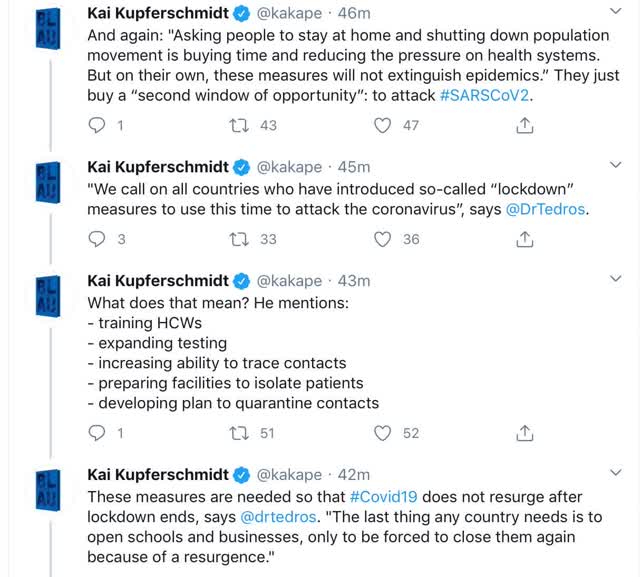
In summary, to be effective, a relatively short period of total lockdown needs to be used to ramp up testing, tracing, and quarantining. Once that is accomplished, and re-transmission of the virus is brought down to lower levels, then a South Korea-style regimen that allows the general lockdown to end can be implemented.
Obama Medicare Chief, Senior pandemic researcher add support for first China, then South Korea plan
- by New Deal democrat
In the last 24 hours, I’ve read more support from experts for the plan that we need at least a short period of China (total lockdown) followed by an extended period of South Korea (massive testing + quarantining of the infected).
Here is Andy Slavitt, the Medicare, Medicaid, and ACA Chief under President Obama:
The biggest problem, aside from the fact that there is no nationwide shutdown at present, is the massive shortage of available testing:
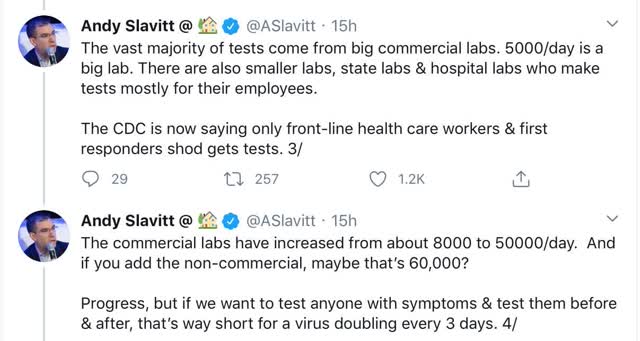
And here is Jeremy Konyndyk, a senior policy fellow at the Center for Global Development, whose research focuses on humanitarian response, USAID policy reform, and global outbreak preparedness:
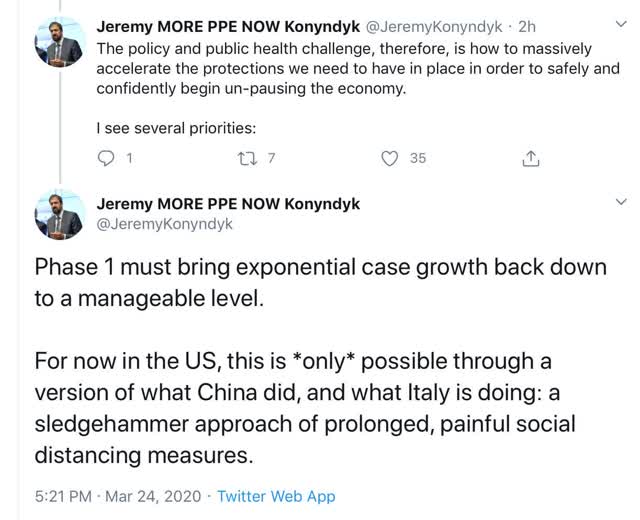
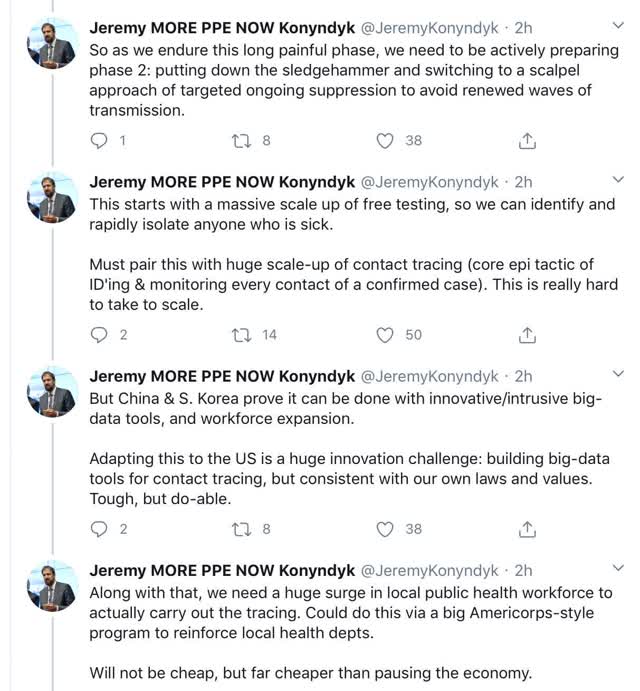
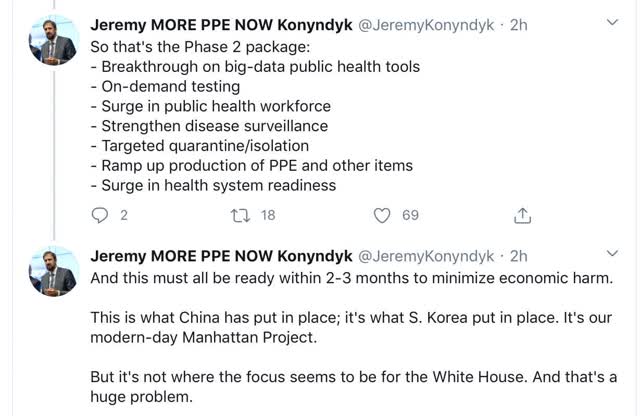
The plan we should be following is pretty clear.
It is also abundantly clear that the federal government under Trump is not going to follow this plan. Therefore it is up to a critical mass of States and governors, and Congress if they can muster a veto-proof majority, to implement it.